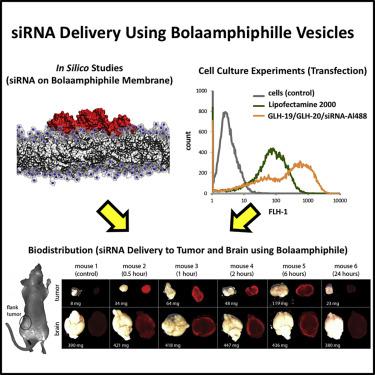Molecular Therapy - Nucleic Acids ( IF 6.5 ) Pub Date : 2020-03-04 , DOI: 10.1016/j.omtn.2020.02.011 Taejin Kim 1 , Mathias Viard 2 , Kirill A Afonin 3 , Kshitij Gupta 1 , Mary Popov 4 , Jacqueline Salotti 5 , Peter F Johnson 5 , Charles Linder 4 , Eliahu Heldman 4 , Bruce A Shapiro 1

|
Small interfering RNAs (siRNAs) are potential therapeutic substances due to their gene silencing capability as exemplified by the recent approval by the US Food and Drug Administration (FDA) of the first siRNA therapeutic agent (patisiran). However, the delivery of naked siRNAs is challenging because of their short plasma half-lives and poor cell penetrability. In this study, we used vesicles made from bolaamphiphiles (bolas), GLH-19 and GLH-20, to investigate their ability to protect siRNA from degradation by nucleases while delivering it to target cells, including cells in the brain. Based on computational and experimental studies, we found that GLH-19 vesicles have better delivery characteristics than do GLH-20 vesicles in terms of stability, binding affinity, protection against nucleases, and transfection efficiency, while GLH-20 vesicles contribute to efficient release of the delivered siRNAs, which become available for silencing. Our studies with vesicles made from a mixture of the two bolas (GLH-19 and GLH-20) show that they were able to deliver siRNAs into cultured cancer cells, into a flank tumor and into the brain. The vesicles penetrate cell membranes and the blood-brain barrier (BBB) by endocytosis and transcytosis, respectively, mainly through the caveolae-dependent pathway. These results suggest that GLH-19 strengthens vesicle stability, provides protection against nucleases, and enhances transfection efficiency, while GLH-20 makes the siRNA available for gene silencing.
中文翻译:

用于将 siRNA 递送到肿瘤和脑中的阳离子 Bola 两亲性囊泡的表征。
小干扰 RNA (siRNA) 因其基因沉默能力而成为潜在的治疗物质,美国食品和药物管理局 (FDA) 最近批准的第一种 siRNA 治疗剂 (patisiran) 就是例证。然而,裸露 siRNA 的递送具有挑战性,因为它们的血浆半衰期短且细胞渗透性差。在这项研究中,我们使用由双亲菌 (bolas)、GLH-19 和 GLH-20 制成的囊泡,研究它们在将 siRNA 递送至靶细胞(包括大脑细胞)时保护 siRNA 免遭核酸酶降解的能力。基于计算和实验研究,我们发现GLH-19囊泡在稳定性、结合亲和力、核酸酶保护和转染效率方面比GLH-20囊泡具有更好的递送特性,而GLH-20囊泡有助于有效释放递送的 siRNA 可用于沉默。我们对由两种 bolas(GLH-19 和 GLH-20)混合物制成的囊泡进行的研究表明,它们能够将 siRNA 递送到培养的癌细胞、侧翼肿瘤和大脑中。囊泡分别通过胞吞作用和转胞吞作用穿透细胞膜和血脑屏障(BBB),主要通过小窝依赖性途径。这些结果表明,GLH-19 增强了囊泡稳定性,提供了针对核酸酶的保护,并提高了转染效率,而 GLH-20 使 siRNA 可用于基因沉默。











































 京公网安备 11010802027423号
京公网安备 11010802027423号